
Proustite is a sulfosalt mineral consisting of silver sulfarsenide, Ag3AsS3, known also as light red silver or ruby silver ore, and an important source of the metal. It is closely allied to the corresponding sulfantimonide, pyrargyrite, from which it was distinguished by the chemical analyses of Joseph L. Proust (1754–1826) in 1804, after whom the mineral received its name.
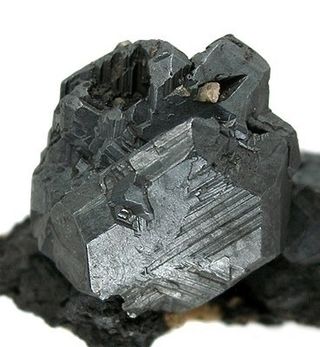
Chalcocite, copper(I) sulfide (Cu2S), is an important copper ore mineral. It is opaque and dark gray to black, with a metallic luster. It has a hardness of 2.5–3 on the Mohs scale. It is a sulfide with a monoclinic crystal system.
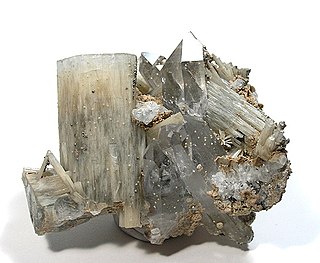
Zinnwaldite, KLiFeAl(AlSi3)O10(OH,F)2, potassium lithium iron aluminium silicate hydroxide fluoride is a silicate mineral in the mica group. The IMA status is as a series between siderophyllite (KFe2Al(Al2Si2)O10(F,OH)2) and polylithionite (KLi2AlSi4O10(F,OH)2) and not considered a valid mineral species.

Tusionite is a rare colorless to transparent to translucent yellow brown trigonal borate mineral with chemical formula: MnSn(BO3)2. The mineral is composed of 18.86% manganese, 40.76% tin, 7.42% boron, and 32.96% oxygen. It is a late stage hydrothermal mineral and occurs rarely in granite pegmatites in miarolitic cavities.

Elbaite, a sodium, lithium, aluminium boro-silicate, with the chemical composition Na(Li1.5Al1.5)Al6Si6O18(BO3)3(OH)4, is a mineral species belonging to the six-member ring cyclosilicate tourmaline group.

Lithiophilite is a mineral containing the element lithium. It is lithium manganese(II) phosphate with chemical formula LiMnPO4. It occurs in pegmatites often associated with triphylite, the iron end member in a solid solution series. The mineral with intermediate composition is known as sicklerite and has the chemical formula Li(Mn,Fe)PO4). The name lithiophilite is derived from the Greek philos (φιλός) "friend," as lithiophilite is usually found with lithium.
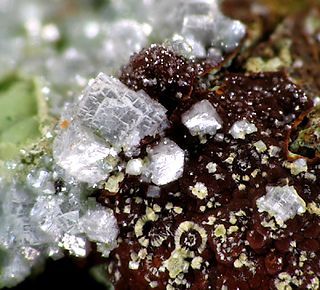
Otavite is a rare cadmium carbonate mineral with the formula CdCO3. Otavite crystallizes in the trigonal system and forms encrustations and small scalenohedral crystals that have a pearly to adamantine luster. The color is white to reddish to yellow brown. Its Mohs hardness is 3.5 to 4 and the specific gravity is 5.04. Associated minerals include azurite, calcite, malachite, and smithsonite.

Sugilite ( SOO-gə-lyte, -jee-) is a relatively rare pink to purple cyclosilicate mineral with the complex chemical formula KNa2(Fe, Mn, Al)2Li3Si12O30. Sugilite crystallizes in the hexagonal system with prismatic crystals. The crystals are rarely found and the form is usually massive. It has a Mohs hardness of 5.5–6.5 and a specific gravity of 2.75–2.80. It is mostly translucent. Sugilite was first described in 1944 by the Japanese petrologist Ken-ichi Sugi (1901–1948) for an occurrence on Iwagi Islet, Japan, where it is found in an aegirine syenite intrusive stock. It is found in a similar environment at Mont Saint-Hilaire, Quebec, Canada. In the Wessels mine in Northern Cape Province of South Africa, sugilite is mined from a strata-bound manganese deposit. It is also reported from Liguria and Tuscany, Italy; New South Wales, Australia and Madhya Pradesh, India.
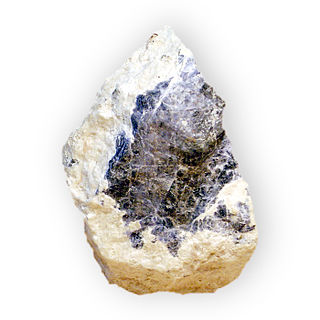
Cancrinite is a complex carbonate and silicate of sodium, calcium and aluminium with the formula Na6Ca2[(CO3)2|Al6Si6O24]·2H2O. It is classed as a member of the feldspathoid group of minerals; the alkali feldspars that are poor in silica. Yellow, orange, pink, white or even blue, it has a vitreous or pearly luster; a hardness of 5–6 and an uneven conchoidal fracture. It is unusual among the silicate minerals in that it will effervesce with hydrochloric acid due to the associated carbonate ions.

Calderite is a mineral in the garnet group with the chemical formula (Mn2+, Ca)3(Fe3+, Al)2(SiO4)3.
Saliotite is a rare colorless to pearl white phyllosilicate mineral in the smectite group with formula (Li,Na)Al3(AlSi3O10)(OH)5. It is an ordered 1:1 interstratification of cookeite and paragonite. It has perfect cleavage, a pearly luster and leaves a white streak. Its crystal structure is monoclinic, and it is a soft mineral with a hardness rated 2-3 on the Mohs scale.

Chloritoid is a silicate mineral of metamorphic origin. It is an iron magnesium manganese alumino-silicate hydroxide with formula (Fe, Mg, Mn)
2Al
4Si
2O
10(OH)
4. It occurs as greenish grey to black platy micaceous crystals and foliated masses. Its Mohs hardness is 6.5, unusually high for a platy mineral, and it has a specific gravity of 3.52 to 3.57. It typically occurs in phyllites, schists and marbles.

Jacobsite is a manganese iron oxide mineral. It is in the spinel group and forms a solid solution series with magnetite. The chemical formula is (Mn,Mg)Fe2O4 or with oxidation states and substitutions: (Mn2+,Fe2+,Mg)(Fe3+,Mn3+)2O4.

Zabuyelite is the natural mineral form of lithium carbonate, with a formula Li2CO3. It was discovered in 1987 at Lake Zabuye, Tibet, after which it is named. It forms colorless vitreous monoclinic crystals.

Zakharovite is a mineral, a silicate of sodium and manganese; formula Na4Mn5Si10O24(OH)6·6H2O. It has a yellow colour with a pearly lustre. Discovered in 1982 in the Kola peninsula of Northern Russia, it is named after Evgeny Evgenevich Zakharov (1902–1980), the director of the Moscow Institute of Geological Exploration.
Zincobotryogen is a hydrous sulfate mineral with the chemical formula (Zn,Mg,Mn)Fe3+(SO4)2(OH)·7H2O. It forms bright orange red monoclinic prismatic crystals that exhibit a vitreous to greasy luster. Its specific gravity is 2.201 and it has a Mohs hardness of 2.5.

Zirconolite is a mineral, calcium zirconium titanate; formula CaZrTi2O7. Some examples of the mineral may also contain thorium, uranium, cerium, niobium and iron; the presence of thorium or uranium would make the mineral radioactive. It is black or brown in color.
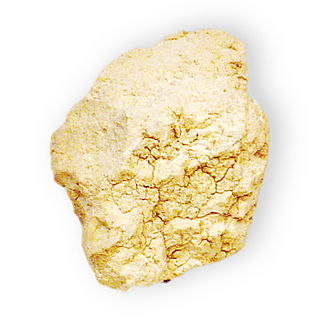
Hectorite is a rare soft, greasy, white clay mineral with a chemical formula of Na0.3(Mg,Li)3Si4O10(OH)2.
Lithiophosphate is a natural form of (pure) lithium orthophosphate. It is an exceedingly rare mineral, occurring in some special types of pegmatites.
















